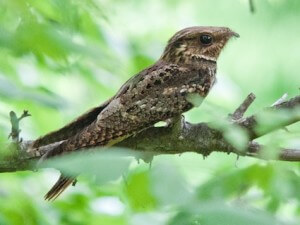 Documented rare species at Badger Army Ammunition Plant include the Eastern Whip-poor-will. Made famous in folk songs, poems, and literature for their endless chanting on summer nights, Whip-poor-wills are easy to hear but hard to see. Their brindled plumage blends perfectly with the gray-brown leaf litter of the open forests where they breed and roost. These birds are on the decline in parts of their range as open forests are converted to suburbs or agriculture.
Documented rare species at Badger Army Ammunition Plant include the Eastern Whip-poor-will. Made famous in folk songs, poems, and literature for their endless chanting on summer nights, Whip-poor-wills are easy to hear but hard to see. Their brindled plumage blends perfectly with the gray-brown leaf litter of the open forests where they breed and roost. These birds are on the decline in parts of their range as open forests are converted to suburbs or agriculture.
Acoustic interference from noise can hamper the detection of song by birds of the same species, making it more difficult for them to establish and maintain territories, attract mates, and/or maintain pair bonds. This, in turn, may reduce breeding success in noisy roadside habitats. When begging for food, nestlings may need to call louder to elicit the desired response from their parents, thereby increasing the energetic cost of obtaining food and potentially decreasing fitness.
High levels of traffic noise may also interfere with the detection of alarm calls such as those signaling the presence of predators, which may lead to higher rates of predation. In addition to road noise, scientific studies have documented a correlation between high urban noise levels and songbird diversity – the more noise, the fewer the number of bird species.
There is significant scientific literature documenting the physical and ecological effects of off-road vehicle use, ranging from soil compaction to non-native plant dispersal. However, the most widespread impact on songbirds and other wildlife is disturbance. Disruption of breeding and nesting birds is a particularly well documented problem.
Many species are sensitive to human disturbance with the potential disruption of courtship activities, over-exposure of eggs or young birds to weather, and premature fledging of juveniles. Repeated disturbance can eventually lead to nest abandonment and long-term bird community changes.
All of these considerations make clear that high-impact use and sound disturbance will be detrimental to birds at Badger. What will be the future of these lands, and will we hear the song of the Whip-poor-will?
To hear the song of the Eastern Whip-poor-will, go to: http://www.allaboutbirds.org/guide/eastern_whip-poor-will/sounds
References:
- Anthropogenic noise decreases urban songbird diversity and may contribute to homogenization, Global Change Biology, Volume 19, Issue 4, pages 1075–1084, April 2013.
- Cornell Lab of Ornithology, All about Birds, accessed online at allaboutbirds.org.
- Eastern Whip-poor-will, photograph by Stephen Ramirez.
- Parris, K. M., and A. Schneider (2008), Impacts of traffic noise and traffic volume on birds of roadside habitats. Ecology and Society 14(1): 29.
- Switalski, Jones / Journal of Conservation Planning Vol 8 (2012) 12-24, Off-road vehicle best management practices for forestlands: A review of scientific literature and guidance for managers.
- Wisconsin Department of Natural Resources, Regional & Property Analysis: Sauk Prairie Recreation Area, July 2012.
- Wisconsin’s Natural Heritage Inventory Program, Bureau of Endangered Resources, Rapid Ecological Assessment for the Sauk Prairie Recreation Area, December 2011.

